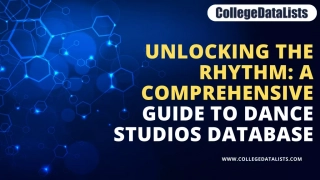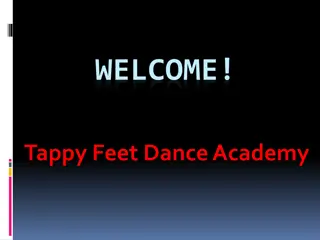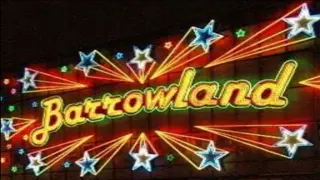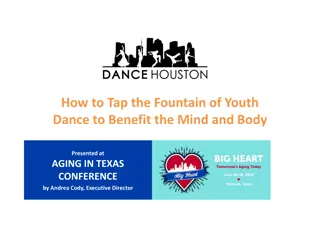SWANSONG Fact Sheet: Christopher Bruce's Contemporary Dance Masterpiece
"Explore the fascinating world of 'SWANSONG,' a renowned contemporary dance piece choreographed by Christopher Bruce. Learn about the choreographer, dance companies that performed the work, its debut in November 1997, the dance style incorporating physical contact and balletic movements, and its thematic inspiration from human rights and prisoner of conscience. Delve into the choreographic styles and unique structure of the performance, driven by diverse stimuli from Amnesty International to literary works. Experience the episodic, dramatic, and thematic elements that make 'SWANSONG' a captivating masterpiece in the world of modern dance."
Download Presentation

Please find below an Image/Link to download the presentation.
The content on the website is provided AS IS for your information and personal use only. It may not be sold, licensed, or shared on other websites without obtaining consent from the author.If you encounter any issues during the download, it is possible that the publisher has removed the file from their server.
You are allowed to download the files provided on this website for personal or commercial use, subject to the condition that they are used lawfully. All files are the property of their respective owners.
The content on the website is provided AS IS for your information and personal use only. It may not be sold, licensed, or shared on other websites without obtaining consent from the author.
E N D
Presentation Transcript
SWANSONG Fact Sheet
CHOREOGRAPHER Christopher Bruce Bruce was awarded with a CBE for a lifetime s service to dance because he was one of Britain s leading choreographers. His most famous pieces include, Cruel garden, Ghost dances, Sergeant Early s Dream, Intimate Pages and Swansong.
DANCE COMPANY Various Dance Companies have performed the work including Rambert Dance Company Rambert Dance Company, once Ballet Rambert, is a modern touring contemporary dance company based in Chiswick, London.
DATE OF FIRST PERFORMANCE November 1997
DANCE STYLE Contemporary, with physical contact and some balletic movements. Includes references to social dance, ballroom, theatrical dance and tap.
CHOREOGRAPHIC STYLE DEFINITIONS Episodic Story Unfolds a section at a time 1. Relating to or resembling an episode. 2. Composed of a series of episodes: an episodic novel. 3. Limited to the duration of an episode; temporary Dramatic Contains elements of drama 1. Of or relating to drama or the theatre. 2. Characterized by or expressive of the action or emotion associated with drama or the theatre: a dramatic rescue at sea. 3. Arresting or forceful in appearance or effect: a dramatic sunset. 4. Music Having a powerful, expressive singing voice: a dramatic tenor. Thematic It has a theme 1. Of, relating to, or being a theme: a scene of thematic importance. 2. Linguistics Of, constituting, or relating to the theme of a word: a thematic vowel.
THEME Human Rights Prisoner of conscience definition Any person who is physically restrained (by imprisonment or otherwise) from expressing (in any form of words or symbols) any opinion which he honestly holds and which does not advocate or condone personal violence." We also exclude those people who have conspired with a foreign government to overthrow their own.
STIMULUS (STARTING POINT) The work of Amnesty International Saying goodbye to a career as a dancer The experiences of Chilean poet Victor Jara The novel A Man by Oriana Fallaci
STRUCTURE Introduction followed by 7 sections. The victim remains on stage throughout and performs a solo in section 3 which has motifs that are repeated and/or developed in sections 5 and 7.
INTRODUCTION Swansong opens with the victim/prisoner sitting on a chair stage right. The interrogators enter one after the other from stage right and, before any music begins, perform a tapping sequence. This establishes that the two of them form a team before they take up positions either side of the victims chair, alternately tapping out questions to which the victims makes no response. Initially this seems light-hearted, almost a game, but with the first electronic crash which signals the start of the first group dance the mood becomes more threatening.
SECTION ONE QUESTION AND ANSWER At the start of the music the victim is pulled off his chair by one of the interrogators. The opening sequence of movement and music is repeated suggesting a repetition of interrogation. Throughout the section the dance changes from trios to brief duets and solo s. In the duets the interrogators dance in unison, or they perform the same material one slightly after the other. In the victims brief solo s, performed as if he was answering back defiantly, he incorporates arabesques, leaps and open arm gestures, perhaps our first indication of the idea of flight. In this section the chair is held with the seat towards the victim s chest, legs facing away, as if used as a shield for the victim. At the end of the section the victim is sitting back on the chair with all three dances taking up their opening positions.
SECTION TWO TEA FOR TWO The second section begins with another interrogation. This time the victim taps out answers in a defiant mood. The first interrogator places a red nose on the victim, then they place caps on their heads. Beginning upstage left they perform a humorous, soft-shoe tango-style duet. The victim is then drawn into this as he becomes one of the guard s partners. This moves in to a section where all three dance in unison. The interrogators dance with confidence whilst the victim is trying to follow their steps. We get the impression that the interrogators are humiliating and playing with the victim. The chair plays an increasingly significant role being constantly shifted beyond the prisoners reach. The end of the dance becomes increasingly violent and the victim appears to snap leaping to his feet and frantically tapping out his hysterical response. He is sat down and the red nose removed. Both interrogators leave the stage although the first returns briefly to light a cigarette. This is the only occasion when one of the interrogators is seen.
SECTION THREE FIRST SOLO The movement and the music of section 3 contrasts with the torture of the previous section. The victim appears to be showing his frustration and anger as well as his urge for freedom. The section begins with a crashing sound which suggest the slamming of a door. Te section starts with the victim crouching as he moves off the chair, he curves his arms behind him, in a bird like gesture. He steps towards and reaches towards the light, representing his longing to escape. The dance moves a long the diagonal line formed by the shaft of light from upstage left. The solo combines classical dance with contemporary. He used lots of deep plies, off balance positions, jumps, arabesques and attitudes and lots of gestures with the arms showing wing like actions or shapes. Twice in this solo the victim curls up on the floor in a defensive twist perhaps representing his tortured soul. The solo ends with the victim returning to the chair and taking up his original position as the interrogators return.
SECTION FOUR SLOW TRIO The fourth section begins with the victim being escorted in slow motion with the interrogators at each shoulder. Again the opening sequence is performed twice but at the end of the second time the chair is moved so the victim cannot return to it. This is a recurring theme; the chair being repeated pulled away or placed just beyond his reach. He is pushed and pulled around so it looks like violence in slow motion. The victim curls on the floor (repeating his position from his solo), he is uncurled by the interrogator and the torture continues. Throughout this section all 3 dancers are involved in lots of lifts and the chair is used as a weapon against the victim. At the end he is held upside down over the chair, struggling, suggesting that his head is being held underwater. He is then left alone on the floor crushed under the chair.
SECTION FIVE SECOND SOLO (PERFORMED WITHOUT ACCOMPANIMENT) This solo does repeat some of the actions from the first solo such as jumps and arabesques but it is more mimetic, (includes more actions that are mimed). At one point the victim lifts the chair onto his back so he appears to be carrying a weight, he holds it in front if his face looking through the bars like the bars of a cell. He stands on the chair looking into the light showing his longing to follow it. The solo ends with his ankles trapped in the bars of the chair as if fettered or shackled. Here it shows that the victim is left with a choice: remain with the chair, his one element of security or move to the light which represents freedom but uncertainty. By resisting the call from the unknown the victim is trapped, literally by the chair.
SECTION SIX CANE DANCE As the interrogators return to the stage the victim sits back down on his chair and watches as they perform a soft-shoe dance with their canes. Gradually the canes become weapons, they use them to beat the victim who uses the chair as a shield. Eventually the interrogators put their canes down and the 3 dancers dance together. Here they repeat movements from the very beginning of the piece. At the end the victim collapses and his limp body is picked up and placed on the chair; the interrogators look at him with frustration and annoyance.
SECTION SEVEN THIRD AND FINAL SOLO During this final section the interrogators remain on stage. They are motionless and remain one on each side of the chair (the same positions they assumed at the very beginning of the dance.) They stand, until the curtain falls, looking at the chair and then the corpse of their dead victim, whose spirit has escaped and the audience see him perform his final solo. This solo begins like the first solo, once he is stood up he turns and walks directly into the light. Much of the solo uses dance movements from the earlier solos and is characterized by the use of arabesques, jumps and bold arm, bird like gestures. However, there are more of the bird like movements and less of the tortured movements. The solo travels further and further upstage left towards the light source. He smiles as he looks back at his prison, then with a gesture of flight he takes off for the world of freedom as he walks offstage into the light. The ending brings a sense of optimism to Swansong whatever the audience s interpretation may be.
DANCERS 3 male dancers 1 prisoner 2 guards
ACCOMPANIMENT By Phillip Chambon Electro-acoustic with digitally sampled sounds, vocals, a reed pipe and popular dance rhythms. Unaccompanied interludes enable us to hear the tapping of the feet. Composed in collaboration with the choreographer.
COSTUME By Christopher Bruce Everyday clothes associated with the role Uniforms for the interrogators Jeans and red t-shirt for the victim
LIGHTING By David Mohr Overhead lighting Diagonal shaft of light to suggest natural light from upstage left Footlights create shadows Atmospheric
SET AND PROPS By Christopher Bruce Bare stage except from chair, suggests a cell Interrogators always exit stage right, suggests a door? Props Chair, Canes, Cigarettes and a Red Nose are used to degrade the victim. The Chair has many purposes, is used symbolically as a weapon, a shield, shackles, a window, a safe place and defence.
STAGING Proscenium Arch
WHAT DO YOU THINK THE STORY IS ABOUT? Write a description of what you think happens
I THINK .... The dance is about a prisoner who is being interrogated by two guards. The guards bully him and mock him but at time try to be friendly to him in a Good Cop, Bad Cop way. Eventually the prisoner gives up and dies, he feels he is set free and I think the light in the back corner represents heaven.
COSTUMES - DESCRIBE THE COSTUMES OF EACH CHARACTER AND GIVE YOUR OPINION ON WHY THEY WERE CHOSEN?
AN EXAMPLE ANSWER ON COSTUMES a pair of blue jeans and a red t-shirt worn by the prisoner/victim and the interrogators are wearing khaki officer suits The convict wears a casual pair of blue denim jeans. The two guards are wearing khaki uniform with dark trousers and a lighter coloured top. Their uniformity helps to emphasise the prisoners isolation. The officers wear camouflaged hats for one of their dance/duets together which help to portray their job as the guards over the convict. The costumes are therefore basic but effective as it is simple to distinguish the characters and depict their various emotions while allowing freedom of movement.
WHY DO YOU THINK THE LIGHTING WAS CHOSEN? DO YOU THINK IT WORKED WELL?
EXAMPLE LIGHTING ANSWER In the Up Stage corner there is a shaft of light which could be seen as a window. The window represents the Prisoners freedom or could be represented as heaven, as he goes into the light at the end. The prisoner dies - symbolically - he walks into a white light. This refers back to the title - as a swan is supposed to sing its most beautiful song just before it dies
TRY SOME EXAMPLE EXAM QUESTIONS. TRY TO COMPLETE ALL QUESTIONS IN DETAIL HOW WOULD YOU DESCRIBE THE ACCOMPANIMENT (MUSIC)?
See full size image HOW WERE THE PROPS USED?























